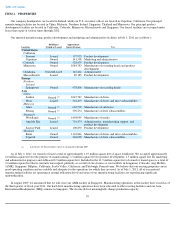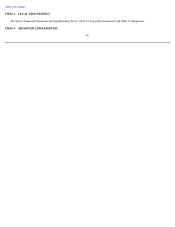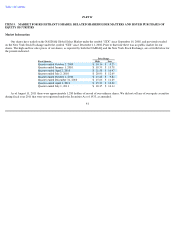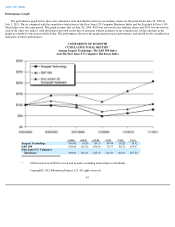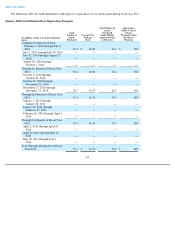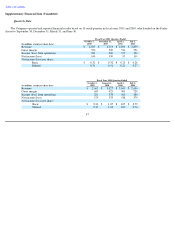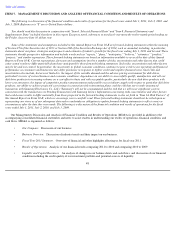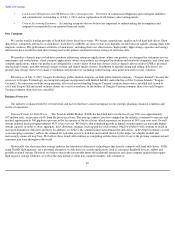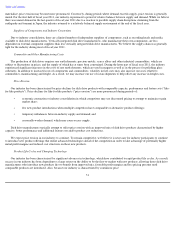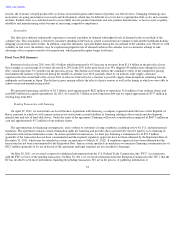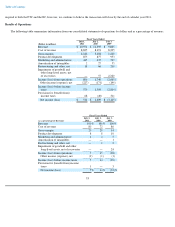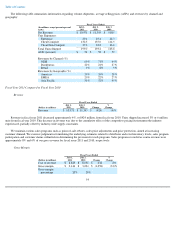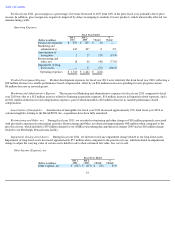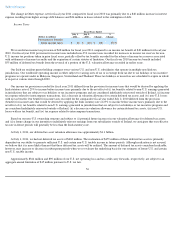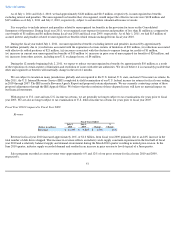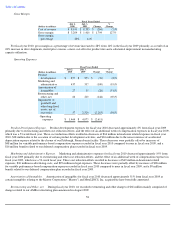Seagate 2010 Annual Report Download - page 52
Download and view the complete annual report
Please find page 52 of the 2010 Seagate annual report below. You can navigate through the pages in the report by either clicking on the pages listed below, or by using the keyword search tool below to find specific information within the annual report.
Table of Contents
• Contractual Obligations and Off-Balance-Sheet Arrangements. Overview of contractual obligations and contingent liabilities
and commitments outstanding as of July 1, 2011 and an explanation of off-balance-sheet arrangements.
• Critical Accounting Estimates. Accounting estimates that we believe are important to understanding the assumptions and
judgments incorporated in our reported financial results.
Our Company
We are the world's leading provider of hard disk drives based on revenue. We design, manufacture, market and sell hard disk drives. Hard
disk drives, commonly referred to as disk drives, hard drives or HDDs, are devices that store digitally encoded data on rapidly rotating disks with
magnetic surfaces. The performance attributes of disk drives, including their cost effectiveness, high quality, high storage capacities and energy
efficiencies have resulted in disk drives being used as the primary medium for mass storage of electronic data.
We produce a broad range of disk drive products addressing enterprise applications, where our products are designed for enterprise servers,
mainframes and workstations; client compute applications, where our products are designed for desktop and notebook computers; and client non-
compute applications, where our products are designed for a wide variety of end user devices such as digital video recorders (DVRs), personal
data backup systems, portable external storage systems and digital media systems. In addition to manufacturing and selling disk drives, we
provide data storage services for small- to medium-sized businesses, including online backup, data protection and recovery solutions.
Effective as of July 3, 2010, Seagate Technology public limited company, an Irish public limited company, ("Seagate-Ireland") became the
successor to Seagate Technology, an exempted company incorporated with limited liability under the laws of the Cayman Islands ("Seagate-
Cayman"). In connection with the reorganization, all issued and outstanding Seagate-Cayman common shares were cancelled and ceased to
exist, and Seagate-Ireland issued ordinary shares on a one-for-one basis to the holders of Seagate-Cayman common shares for each Seagate-
Cayman common share that was cancelled.
Business Overview
Our industry is characterized by several trends and factors that have a material impact on our strategic planning, financial condition and
results of operations.
Demand Trends for Disk Drives. The Total Available Market (TAM) for hard disk drives in the fiscal year 2011 was approximately
657 million units, an increase of 4% from the prior fiscal year. The average capacity per drive shipped by the industry continued to increase and
reached approximately 560 gigabytes per unit in the last quarter of the fiscal year, which represents an increase of 34% year over year. Overall
storage demand increased approximately 40% year over year. We believe that continued growth in digital content requires increasingly higher
storage capacity in order to store, aggregate, host, distribute, manage, back up and use such content, which we believe will continue to result in
increased demand for disk drive products. In addition, we believe the continued increased demand for disk drives, in developed countries as well
as in emerging economies, reflects the demand for real-time access to rich data and content driven by the impact of a highly mobile and
increasingly connected user base. We believe these trends will continue as computing architectures evolve to serve the growing commercial and
consumer user base throughout the world.
Historically, the electronic data storage industry has introduced alternative technologies that directly compete with hard disk drives. SSDs,
using NAND flash memory, are a potential alternative to disk drives in certain applications such as consumer handheld devices, tablets and
portable external storage. However, we believe that in the foreseeable future the traditional enterprise and client compute markets that require
high capacity storage solutions, as well as the data intensive client non-compute markets, will continue to
49


